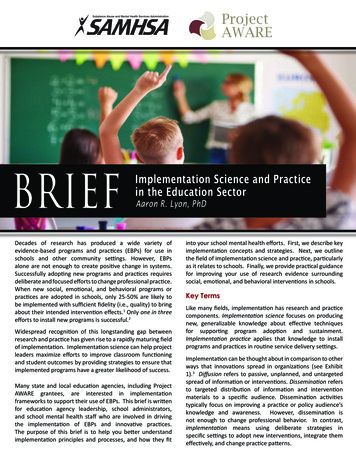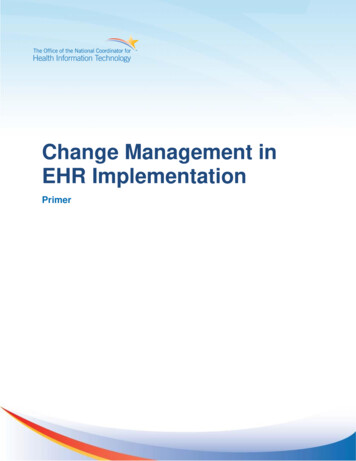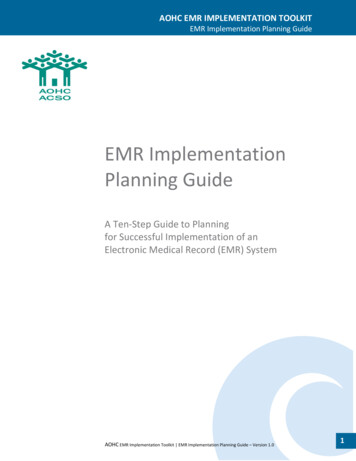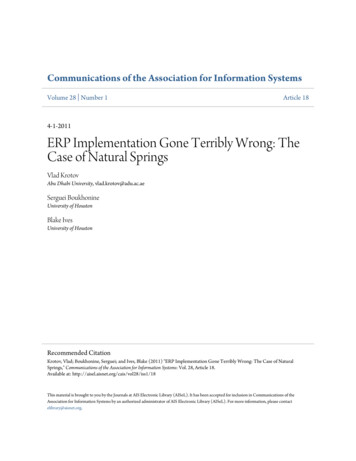
Transcription
BRIEFImplementation Science and Practicein the Education SectorAaron R. Lyon, PhDDecades of research has produced a wide variety ofevidence‑based programs and practices (EBPs) for use inschools and other community settings. However, EBPsalone are not enough to create positive change in systems.Successfully adopting new programs and practices requiresdeliberate and focused efforts to change professional practice.When new social, emotional, and behavioral programs orpractices are adopted in schools, only 25-50% are likely tobe implemented with sufficient fidelity (i.e., quality) to bringabout their intended intervention effects.1 Only one in threeefforts to install new programs is successful.2Widespread recognition of this longstanding gap betweenresearch and practice has given rise to a rapidly maturing fieldof implementation. Implementation science can help projectleaders maximize efforts to improve classroom functioningand student outcomes by providing strategies to ensure thatimplemented programs have a greater likelihood of success.Many state and local education agencies, including ProjectAWARE grantees, are interested in implementationframeworks to support their use of EBPs. This brief is writtenfor education agency leadership, school administrators,and school mental health staff who are involved in drivingthe implementation of EBPs and innovative practices.The purpose of this brief is to help you better understandimplementation principles and processes, and how they fitinto your school mental health efforts. First, we describe keyimplementation concepts and strategies. Next, we outlinethe field of implementation science and practice, particularlyas it relates to schools. Finally, we provide practical guidancefor improving your use of research evidence surroundingsocial, emotional, and behavioral interventions in schools.Key TermsLike many fields, implementation has research and practicecomponents. Implementation science focuses on producingnew, generalizable knowledge about effective techniquesfor supporting program adoption and sustainment.Implementation practice applies that knowledge to installprograms and practices in routine service delivery settings.Implementation can be thought about in comparison to otherways that innovations spread in organizations (see Exhibit1).3 Diffusion refers to passive, unplanned, and untargetedspread of information or interventions. Dissemination refersto targeted distribution of information and interventionmaterials to a specific audience. Dissemination activitiestypically focus on improving a practice or policy audience’sknowledge and awareness. However, dissemination isnot enough to change professional behavior. In contrast,implementation means using deliberate strategies inspecific settings to adopt new interventions, integrate themeffectively, and change practice patterns.
“Letting it happen”“Helping it happen”“Making it ve, unplanned,and untargetedspread of informationTargeted distributionof information andintervention materialsto a specific audienceUse of strategies toadopt and integrateinterventions and changepractice patterns inspecific settingsExhibit 1: Definitions of Diffusion, Dissemination, and Implementation (from Greenhalgh et al.3)Implementation Objectives & StrategiesImplementation focuses on identifying and addressingmulti-level factors that help or impede EBP adoption andsustainment. Most often, this is done by identifying andapplying specific implementation strategies. Implementationstrategies are systematic intervention processes to adoptand integrate evidence-based interventions or practices intousual services.4Implementation strategies are designed to improve implementationoutcomes and service outcomes. Implementation outcomesrefer to the effects of an implementation strategy onthe new intervention, practice, or service. Examples ofimplementation outcomes might include adoption, fidelity,or penetration/reach.5 Service or intervention outcomesrefer to the impact that the new intervention, practice, orservice has on individuals, focus populations, or systems. Forexample, improvement in child and family functioning wouldbe a service outcome. Exhibit 2 shows the relationship amongimplementation strategies, implementation outcomes, andservice outcomes.Strategies in Action. More than 70 implementation strategieshave been identified.7 The large majority of them are relevantto implementation and sustainment of EBPs in schools (seeExhibit 3 for examples). It is important to recognize that inmost cases, full implementation is a long process, sometimestaking 2-3 years or more.8 This is important to know becausemost projects use evaluation data to assesswhether or not a new2Implementation Science and Practice in the Education Sectorprogram is successful. Evaluation is an essential part of theimplementation process. However, we need to considerwhether a new program is fully implemented before usingdata to assess effectiveness. If we use the data too soon,an evaluation may wrongly conclude that the EBP wasineffective, when really the full program was never installed.One of the most robust implementation science findingsin the last 15-20 years is that one-time, “train and hope”professional development models are largely ineffective forproducing professional behavior change.9,10 No matter howlong or intensive a training, the content is extremely unlikelyto be used effectively in practice without post-trainingsupports. For example, even trainings that last a week or morewill be ineffective unless they are paired with supports likeongoing, targeted consultation or coaching. Implementationscience research has also shown that even with high-qualityimplementation, sustained program use (i.e., continuedapplication of the practice in a service context) is difficultto achieve.11 Usually only parts of any given program aresustained in the long term. Often, only some of the individualscontinue to use a program, or practitioners may continue touse only a subset of program components.12Implementation FrameworksThere are numerous implementation frameworks. Aframework is an important tool to help schools useimplementation science to support specific programs.Selection of implementation strategies should be driven byone or more implementation frameworks. Implementation
frameworks articulate and organize key variables that needto be considered when implementing new programs andpractices. Most implementation frameworks share a set ofcommon themes. These include:1. Implementation unfolds over time or through stages/phases. These phases may include pre-implementation(e.g., when systems are contemplating or exploringa change effort) and continue into a maintenance orsustainment phase.2. Implementation occurs in complex, multilevel systems.Addressing multiple levels simultaneously has beenfound to result in improved implementation success.Levels most often include: The intervention or practice being implemented Service recipients (e.g., students) Professionals/practitioners (e.g., teachers, clinicians) The immediate organization or “inner context” inwhich implementation occurs (e.g., school buildingsor districts) The broader “outer context” (e.g., policy context,interorganizational linkages)3. There is a bidirectional relationship between settingsand EBPs. Both are likely to require some degree ofadaption for implementation to be successful. For EBPs, any adaptation should focus on componentsthat are not considered critical to its effectiveness.Core EBP elements should not be adapted. For settings, adaptation may focus on changingaspects such as organizational policies, leadership, orinfrastructure.Although more than 60 dissemination and implementationframeworks have been identified,15 no one framework hasbeen demonstrated to be superior or more consistentlyuseful. The selection of an implementation frameworkshould therefore be driven by the objectives and specificfocus of the implementation project. A non-exhaustive listof implementation frameworks that have been successfullyused in schools includes: Exploration, Preparation, Implementation, Sustainment(EPIS) Framework16 Interactive Systems Framework (ISF)17Intervention StrategiesEvidence-Based PracticesImplementation StrategiesExamplesActive TrainingConsultationLeadership TrainingSystem IncentivesOutcomesImplementation tainmentStudent Social, Emotional,Behavioral, and Academic OutcomesExhibit 2: Conceptual RelationshipAmong EBPs, ImplementationStrategies, and Outcomes(adapted from Proctor et al.6) The National Implementation Research Network’s(NIRN) Active Implementation Frameworks (AIF)9 The Multilevel Implementation Quality Framework18 The Consolidated Framework for ImplementationResearch (CFIR)1Implementation Science and Practice in the Education Sector3
Exhibit 3: Example Implementation Strategies for Schools (Lyon, Cook et al.13; adapted from Powell et al.6)Strategy4DefinitionExamplesConductlocal consensusdiscussionsInclude local teachers, staff, andstakeholders in discussions thataddress whether (1) the identifiedproblem/need is important and(2) whether new practices toaddress the identified problemare appropriate.School “A” identifies a need to improve classroom behavior as a high priority. School“A” administrators identify relevant stakeholders (e.g., teachers, counselors, andparents) to engage in a problem-solving process. Together, the group identifiesthe scope of the problem; helps select the Good Behavior Game as their EBP;and discusses ways to build school consensus about the objectives, timeline, andanticipated outcomes of implementation.Identifyand preparechampionsIdentify and prepare key peoplewho can dedicate themselvesto supporting, marketing, anddriving through an implementationprocess.School “B” is preparing to implement a new, evidence-based social emotionallearning (SEL) curriculum. The school distributes surveys to teaching staff askingthem which colleagues they regularly approach when they have students whoare experiencing problems. Teachers who are consistently nominated receivespecial training and (non-monetary) incentives to ensure their engagement in theimplementation effort. These teachers are established as local experts on theintervention and serve as resources for their colleagues.Recruit,designate,and train forleadershipRecruit, designate, and trainleaders for the change effort sothey can effectively engage inleadership behaviors that supportothers to adopt and deliver thenew practice.Clinicians at Community-based Mental Health Agency “C” frequently workin schools in the area, which is rural. One of these schools is beginningimplementation of the Cognitive Behavioral Intervention for Trauma in Schools(CBITS). Clinical supervisors at the agency are given special supports (e.g., training,periodic consultation) to help them provide clear, consistent, positive messagingabout CBITS.Make trainingdynamicVary information delivery methodsto be interactive, cater to differentlearning styles, and allow forprofessional development.School “A” has begun implementing Good Behavior Game. The school providesin-person teacher training that involves active practice by everyone in attendance;opportunities to observe other instructors model program delivery; and directfeedback about teachers’ performance during practice activities.PromoteadaptabilityIdentify the ways a new practicecan be tailored or adapted to bestfit with the school or classroomcontext and meet local needs.Clarify which elements of thenew practice must be maintainedto preserve fidelity.Following the implementation of the CBITS group intervention, the interventiondevelopers and the local implementers (i.e., school-based clinicians fromCommunity Mental Health Agency “C”) discuss aspects of the program that may beinterfering with successful implementation. They identify needed adaptations forthe school’s large population of students who are immigrants and English languagelearners. They decide to change some of the relaxation exercises to more closelyalign with the experiences of immigrants. This discussion focuses on figuring outwhich examples in the program can be changed to be more culturally appropriatewhile keeping the critical components intact.Provide ongoingconsultation orcoachingProvide ongoing consultation orcoaching with one or more experts in the strategies used tosupport implementing new practices.For three months following initial training in the SEL curriculum, teachers at School“B” continue to receive in-person or phone-based support from the original trainersat regularly scheduled times (e.g., weekly or biweekly). On these calls, teachersare able to ask questions, receive feedback on implementation, problem‑solvedifficulties they encounter, and learn from their peers.Facilitate relayof data to schoolpersonnelProvide as close to real-time dataas possible about key measures ofintervention fidelity and studentoutcomes. Use integrated modesand channels of communicationin a way that promotes use of thetargeted new practices.To support implementation of Schoolwide Positive Behavioral Interventions andSupports (SWPBIS), Education Agency “D” sets up quarterly data collection by atrained consultant using the Tiered Fidelity Index (TFI; a leading measure of PBISfidelity). TFI data is then shared educators during quarterly staff meetings. Inthese meetings, administrators review PBIS implementation efforts over the pastquarter and provide space for problem solving.Providesystem-levelincentivesProvide system-level incentives todistricts, schools, or related entitiesto participate and engage in animplementation effort involving anew practice.A state committed to implementing SEL curricula in schools allocates specificfunding and other resources to schools that have demonstrated ongoingcommitment to SEL implementation. To decide which schools receive this funding,the state agency looks at schools’ commitment to processes such as developingan implementation blueprint and timeline, releasing key champions from otherresponsibilities, participating in training and consultation, routinely collecting SELfidelity data, and meeting fidelity benchmarks.Implementation Science and Practice in the Education Sector
this reality is difficult and requires a commitment from alladministrators and personnel involved in an implementationeffort to avoid drawing conclusions about a program and itseffectiveness until multiple years have passed. Communicatethis clearly at the outset and seek formal and publiccommitments from stakeholders to “stay the course.” Workwith stakeholder leaders to identify ways to sustain buy-inover time.Implementation in the School SettingThe remainder of this brief focuses on the implementationchallenges, considerations, and strategies that are particularto schools. School workforce issues, calendars, andorganizational structures uniquely affect implementationprocesses in the education sector.19Workforce and Implementation Agents. School staff are adiverse set of service providers. In some schools, dedicatedbehavioral support personnel and school-based mentalhealth clinicians are available to lead EBP implementation,but administrators, teachers, and support staff are also keyEBP implementers.20 While the most appropriate personnelto implement a new program is sometimes dictated by thetype or intensity of the EBP, schools and other organizationsshould think flexibly about the personnel in school buildingswho might be appropriate to deliver prevention programs.For example, mental health personnel would be best tolead a CBITS trauma intervention, but SEL curricula wouldbe delivered by classroom teachers and even other staffmembers (e.g., administrators, athletic staff). When choosingan intervention, think carefully about the personnel requiredto implement it. Many interventions are specifically designedfor non-clinical school staff to implement.Calendar and Timeline. The school calendar has clearimplications for the sustainment of new programs. Summerbreak is a substantial transition point for both studentsand staff. No programs or practices can truly be consideredsustained until they have continued to be implemented withfidelity over at least 2-3 consecutive school years. AddressingOrganizational Factors. Finally, as with any other setting,organizational factors are critical to implementation in schools.Among the most critical determinants of implementationsuccess is implementation leadership,21 and there is growingrecognition that school leadership is essential for programsuccess. Although principals may be the most relevant leadersfor implementation efforts in many schools, also considerlower-level leaders or leadership teams that may be closerto implementation efforts. Special training or other supportscan be used to help leaders at multiple levels in schoolsand related organizations support EBP implementation bycreating a positive implementation climate. This climate ischaracterized by clear expectations, positive reinforcementfor implementing (e.g., social recognition), and consistentmessages to support the EBP effort.Practical Recommendationsfor Implementation in SchoolsImplementation and sustainment efforts should bedeliberate in their planning and resource allocationprocesses. Picking and choosing different strategies basedon what appears to work in the short term is unlikely topromote effective implementation in the long term. Thatsaid, the recommendations below and the strategies inExhibit 3 provide a helpful starting place for integratingimplementation principles in your efforts.Get system-wide buy-in. Implementation always occursover multiple levels, so it is critical to work toward achievingbuy-in from a wide variety of stakeholders. For example,implementations of Positive Behavioral Interventions andSupports (PBIS) often include the requirement that at least80% of staff endorse the implementation project.22 Facilitatebuy-in by including a range of stakeholders in decision making.6For instance, use local consensus discussions or stakeholderadvisory boards to solicit input on implementation effortsand recommendations for improvements. On an individuallevel, promote buy-in through targeted communications,messages, or testimonials from people who are similar toor respected by your audience. For example, recent workhas used testimonials from teachers about the importanceof proactively supporting students to improve educators’ beliefsand attitudes about EBPs prior to training andconsultation efforts.23Implementation Science and Practice in the Education Sector5
Always provide post-training supports. Front-line serviceprovider behavior change is highly unlikely without posttraining supports such as consultation/coaching, promptsor reminders, active problem solving assistance, and clearaccountability structures (see fidelity measurement, below).Post-training supports like these inevitably add cost to theefforts; providing ongoing consultation can increase the cost ofan implementation initiative by 50%.24 However, not includingpost-training supports may make the implementationunsuccessful and waste the resources devoted to the initialtraining.Ensure fidelity through routine measurement. Measuringthe success of implementation initiatives is critical.Importantly, we know that reports of fidelity from front-lineservice providers (e.g., teachers, clinicians) are not stronglyassociated with more objective observations. Because ofthis discrepancy, self-report methods along cannot tellyou if implementation is going as planned. For this reason,evaluation of fidelity should be as objective as possible andcome from an independent information source or sources(e.g., peer observation, student report of teacher practices,expert consultant ratings). Based on your fidelity assessmentdata, provide feedback, structured problem solving, andconsultative supports to the implementers.Note that even when implementation outcomes areadequate, you should not assume that student outcomes areimproving without explicitly evaluating them as well. Whenpossible, this may be most efficiently achieved using existingadministrative data (e.g., student attendance, discipline).Your Project AWARE outcome measures can help youdetermine if EBP implementation is supporting your focuspopulations as expected.Conclusion: Implementationas a Long-Term ProcessThe field of implementation science and practice is rapidlyexpanding. In the education system, where resourcesand time are limited, strategic implementation canoften be the difference between programs that fail andprograms that create sustainable change. More educationleaders recognize the need for a deliberate process ofimplementation when starting new programs and practicesin schools. Implementation is a lengthy and iterative processthat involves planning, service integration, post-trainingsupport, evaluation, and collaborative problem solving.Sustaining buy-in across multiple levels of school leadershipand stakeholders can produce the long-term dedication thatis needed to successfully implement innovative practice forstudent mental health.6Implementation Science and Practice in the Education SectorAdditional ResourcesHistorically, most resources for implementation supportin schools have been focused on specific programs orpractices (e.g., PBIS), rather than providing cross-cuttinginformation and supports that could be used to facilitatethe implementation of any EBP. For further informationon implementation in schools and related contexts, pleasesee the resources below.Web Resources SAMHSA’s implementation rogram “Implementation in Schools” – a brief video funded bythe Canadian Institutes of Health Research:https://www.youtube.com/watch?v XdfPmL4MuIY The National Implementation Research Network’s(NIRN) Active Implementation Hub:http://implementation.fpg.unc.edu The Consolidated Framework for ImplementationResearch’s technical assistance website:http://cfirguide.orgArticles Cook, B.G., & Odom, S.L. (2013). Evidence-basedpractices and implementation science in specialeducation. Exceptional Children, 79, 135-144. Forman, S. G., Shapiro, E. S., Codding, R. S., Gonzales,J. E., Reddy, L. A., Rosenfield, S. A., . & Stoiber,K. C. (2013). Implementation science and schoolpsychology. School Psychology Quarterly, 28(2), 77. Owens, J. S., Lyon, A. R., Brandt, N. E., Warner, C.M., Nadeem, E., Spiel, C., & Wagner, M. (2014).Implementation science in school mental health: Keyconstructs in a developing research agenda. SchoolMental Health, 6(2), 99-111.
Works Cited1. Gottfredson, D. C., & Gottfredson, G. D. (2002).Quality of school-based prevention programs: Resultsfrom a national survey. Journal of Research in Crimeand Delinquency, 39(1), 3-35.2. Damschroder, L. J., Aron, D. C., Keith, R. E., Kirsh, S.R., Alexander, J. A., & Lowery, J. C. (2009). Fosteringimplementation of health services research findingsinto practice: a consolidated framework for advancingimplementation science. Implementation science,4(1), 50.3. Greenhalgh, T., Robert, G., Macfarlane, F., Bate, P.,& Kyriakidou, O. (2004). Diffusion of innovationsin service organizations: systematic review andrecommendations. The Milbank Quarterly, 82(4),581-629.4. Powell, B. J., McMillen, J. C., Proctor, E. K., Carpenter,C. R., Griffey, R. T., Bunger, A. C., . & York, J. L. (2012).A compilation of strategies for implementing clinicalinnovations in health and mental health. Medicalcare research and review, 69(2), 123-157.5. Proctor, E., Silmere, H., Raghavan, R., Hovmand, P., Aarons, G., Bunger, A., . & Hensley, M. (2011). Outcomes forimplementation research: conceptual distinctions, measurement challenges, and research agenda. Administration andPolicy in Mental Health and Mental Health Services Research, 38(2), 65-76.6. Proctor, E. K., Landsverk, J., Aarons, G., Chambers, D., Glisson, C., & Mittman, B. (2009). Implementation research in mentalhealth services: an emerging science with conceptual, methodological, and training challenges. Administration and Policyin Mental Health and Mental Health Services Research, 36(1), 24-34.7. Powell, B. J., Waltz, T. J., Chinman, M. J., Damschroder, L. J., Smith, J. L., Matthieu, M. M., . & Kirchner, J. E. (2015). Arefined compilation of implementation strategies: results from the Expert Recommendations for Implementing Change(ERIC) project. Implementation Science, 10(1), 21.8. Fixsen, D. L., Naoom, S. F., Blase, K. A., & Friedman, R. M. (2005). Implementation research: a synthesis of the literature.9. Herschell, A. D., Kolko, D. J., Baumann, B. L., & Davis, A. C. (2010). The role of therapist training in the implementation ofpsychosocial treatments: A review and critique with recommendations. Clinical psychology review, 30(4), 448-466.10. Joyce, B. R., & Showers, B. (2002). Student achievement through staff development.11. Scheirer, M. A. (2005). Is sustainability possible? A review and commentary on empirical studies on program sustainability.American Journal of Evaluation, 26, 320–347.12. Stirman, S. W., Kimberly, J., Cook, N., Calloway, A., Castro, F., & Charns, M. (2012). The sustainability of new programs andinnovations: a review of the empirical literature and recommendations for future research. Implementation Science, 7(1), 17.13. Lyon, A. R., Cook, C. R., Locke, J., Powell, B. J., & Waltz, T. J. (2017, October). Implementation Strategies to Support Adoptionand Sustainment of Evidence-Based Behavioral Health Practices in the Education Sector. Paper presented at the 2017Center for School Mental Health’s 22nd Annual Conference on Advancing School Mental Health. Washington, DC.14. Beidas, R. S., & Kendall, P. C. (2010). Training therapists in evidence‐based practice: a critical review of studies from asystems‐contextual perspective. Clinical Psychology: Science and Practice, 17(1), 1-30.15. Tabak, R. G., Khoong, E. C., Chambers, D. A., & Brownson, R. C. (2012). Bridging research and practice:models for dissemination and implementation research. American journal of preventive medicine,43(3), 337-350.Implementation Science and Practice in the Education Sector7
16. Aarons, G. A., Hurlburt, M., & Horwitz, S. M. (2011). Advancing a conceptual model of evidence-based practiceimplementation in public service sectors. Administration and Policy in Mental Health and Mental Health Services Research,38(1), 4-23.17. Wandersman, A., Duffy, J., Flaspohler, P., Noonan, R., Lubell, K., Stillman, L., . & Saul, J. (2008). Bridging the gap betweenprevention research and practice: The interactive systems framework for dissemination and implementation. Americanjournal of community psychology, 41(3-4), 171-181.18. Domitrovich, C. E., Bradshaw, C. P., Poduska, J. M., Hoagwood, K., Buckley, J. A., Olin, S., . & Ialongo, N. S. (2008). Maximizingthe implementation quality of evidence-based preventive interventions in schools: A conceptual framework. Advances inSchool Mental Health Promotion, 1(3), 6-28.19. Owens, J. S., Lyon, A. R., Brandt, N. E., Warner, C. M., Nadeem, E., Spiel, C., & Wagner, M. (2014). Implementation sciencein school mental health: Key constructs in a developing research agenda. School mental health, 6(2), 99-111.20. Eber, L., Weist, M., & Barrett, S. (2013). An introduction to the interconnected systems framework. Advancing educationeffectiveness: Interconnecting school mental health and school-wide positive behavior support, 3-17.21. Aarons, G. A., Ehrhart, M. G., Farahnak, L. R., & Sklar, M. (2014). Aligning leadership across systems and organizations todevelop a strategic climate for evidence-based practice implementation. Annual Review of Public Health, 35, 255-274.22. Horner, R. H., Sugai, G., Todd, A. W., & LewisPalmer, T. (2005). School-wide positive behavior support. In L. Bambara & L.Kern (Eds.), Individualized supports for students with problem behaviors: Designing positive behavior plans (pp. 359 –390). New York: Guilford Press.23. Cook, C. R., Lyon, A. R., Kubergovic, D., Wright, D. B., & Zhang, Y. (2015). A supportive beliefs intervention to facilitate theimplementation of evidence-based practices within a multi-tiered system of supports. School mental health, 7(1), 49-60.24. Olmstead, T., Carroll, K. M., Canning-Ball, M., & Martino, S. (2011). Cost and cost-effectiveness of three strategies fortraining clinicians in motivational interviewing. Drug & Alcohol Dependence, 116, 195-202.Toll-Free Phone: (844) 856-1749Email: NITT-TA@cars-rp.orgWebsite: www.samhsa.gov/NITT-TADisclaimer: The views, opinions, and content expressed in this document do not necessarily reflect the views,opinions, or policies of the Center for Mental Health Services (CMHS), the Substance Abuse and MentalHealth Services Administration (SAMHSA), or the U.S. Department of Health and Human Services (HHS).
framework is an important tool to help schools use implementation science to support specific programs. Selection of implementation strategies should be driven by one or more implementation frameworks. Implementation Dissemination Targeted distribution of information and intervention m










